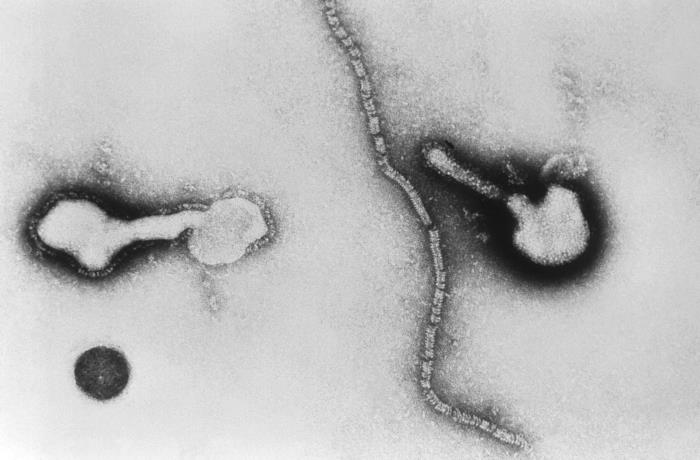Human parainfluenza virus
|
Croup Microchapters |
|
Diagnosis |
|---|
|
Treatment |
|
Case Studies |
|
Human parainfluenza virus On the Web |
|
American Roentgen Ray Society Images of Human parainfluenza virus |
|
Risk calculators and risk factors for Human parainfluenza virus |
| Human parainfluenza virus | ||||||
|---|---|---|---|---|---|---|
 A Transmission Electron Micrograph (TEM) depicting parainfluenza virions, and free filamentous nucleocapsid material.
| ||||||
| Virus classification | ||||||
|
This page is about microbiologic aspects of the organism(s). For clinical aspects of the disease, see Croup.
Editor-In-Chief: C. Michael Gibson, M.S., M.D. [1] Associate Editor(s)-in-Chief: Luke Rusowicz-Orazem, B.S.
Overview
Microbiological Characteristics
- The human parainfluenza virus genome consists of approximately 15,000 nucleotides used to encode the following six structural proteins:.[3]
| Protein | Location | Function |
|---|---|---|
| hemagglutinin | Envelope | Attachment and cell entry |
| fusion protein | Envelope | Fusion and cell entry |
| matrix protein | Within the envelope | Assembly |
| nucleoprotein | Nucleocapsid | Forms a complex with the RNA genome |
| phosphoprotein | Nucleocapsid | Forms as a part of the RNA polymerase complex |
| large protein | Nucleocapsid | Forms as a part of the RNA polymerase complex |
- Human parainfluenza virus is a member of the paramyxoviridae family.
- The genus for human parainfluenza virus depends on its serotype:[3]
- Respirovirus: HPIV-1 & HPIV-3
- Rubulavirus: HPIV-2 & HPIV-4
Transmission
- Human parainfluenza virus is primarily transmitted by the following:[4]
- Airborne respiratory droplets from coughing and sneezing
- Close physical contact with an infected individual
- Physical contact with a contaminated surface
References
- ↑ Vainionpää R, Hyypiä T (1994). "Biology of parainfluenza viruses". Clin. Microbiol. Rev. 7 (2): 265–75. PMC 358320. PMID 8055470.
- ↑ Baron, Samuel (1996). Medical microbiology. Galveston, Tex: University of Texas Medical Branch at Galveston. ISBN 0-9631172-1-1.
- ↑ 3.0 3.1 Henrickson, K. J. (2003). "Parainfluenza Viruses". Clinical Microbiology Reviews. 16 (2): 242–264. doi:10.1128/CMR.16.2.242-264.2003. ISSN 0893-8512.
- ↑ "Human Parainfluenza Viruses | Transmission of HPIVs | CDC".